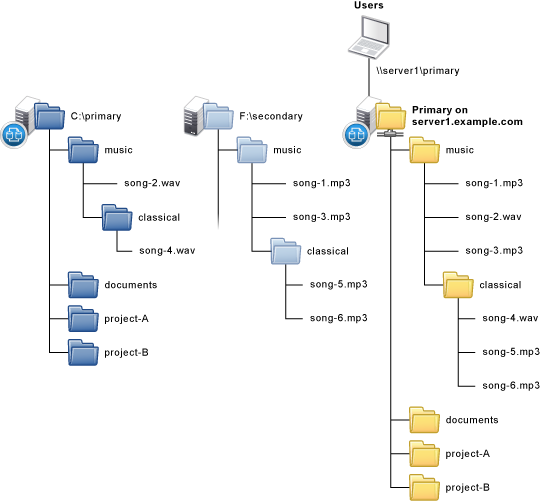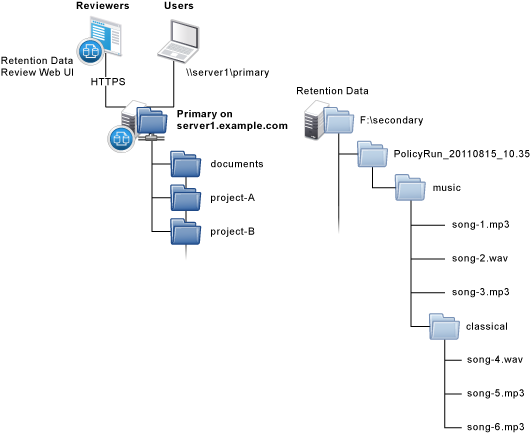1.0 Overview of Dynamic File Services
Novell Dynamic File Services is an information life-cycle management technology. It makes your essential data readily available to users, while tiering files efficiently across a pair of paths, referred to as a pair. You create policies to control how the files are distributed between the two paths. A Dynamic File Services pair consists of two independent share paths in the same Active Directory domain, or on the same server in a Workgroup. Dynamic File Services provides two pair types to address your storage needs: standard pair and retention pair.
The Dynamic File Services standard pair allows you to efficiently manage your storage across a pair of paths while giving users access to files on both. When users connect to a network share on the primary path, they see merged view of files. Users are not aware of where the files physically reside. Files on both paths are equally accessible to users. Dynamic File Services pulls data directly to the user from the primary path or the secondary path, depending on where the file is located.
Figure 1-1 Merged View Access to Files in a Standard Pair

The Dynamic File Services retention pair allows you to keep data that is actively used on the primary path, and to move static data that might occasionally need to be accessed to a retention repository on the secondary path. For example, the repository can store files that are not needed for everyday operations but must be retained for historical reference, or to comply with contractual or legal requirements. Files in the repository are not generally available to users. Only designated reviewers can access them via a Web-based Retention Review tool. You can schedule retention review events and notify multiple recipients about them. Reviewers determine the disposition of retained files in accordance with your company’s data retention policy. All retention review actions are audited.
Figure 1-2 Reviewer and User Access to Files in a Retention Pair

Depending on the type of Dynamic File Services pair, you can combine paths on local, remote, and cloud locations:
-
Local drives: Local drives are the devices mounted as a drive letter on the DynamicFS server.
-
Remote shares: Remote shares reside on network attached storage (such as NetApp and EMC filers) and on supported Windows server platforms. Shares must be located in the same Active Directory domain or Workgroup as the Dynamic FS server.
-
Cloud storage: Cloud storage resides on your storage account on a supported cloud provider site, such as Amazon Simple Storage Service, CloudMe, or Dropbox.
A standard pair combines a local drive as the primary path with a local drive or remote share as the secondary path. A retention pair combines a local drive or remote share as the primary path with a local drive, remote share, or cloud storage as the secondary path.
A Dynamic File Services policy determines what files are moved between the two paths. A policy schedule determines when the files are moved. You can specify one or more conditions to be met, such as frequency of use, file name patterns, file types, file size, and file owners. Policy enforcement is automated with scheduled and on-demand policy runs. You can run multiple policies concurrently on a pair. You can also specify a list of files or folders to be moved during a one-time move from the primary path to the secondary path in a pair.
You can separately back up each path of a pair, which helps to narrow the time window needed for backing up critical data. For example, Dynamic File Services can seamlessly tier files between high-performance and lower-performance storage devices. You can establish policies that keep frequently used mission-critical data on high-performance storage devices, and move seldom-used less-essential data to lower-performance storage devices. Backing up essential files takes less time because the seldom-used files are stored on the secondary path, where they can be backed up separately and less frequently.